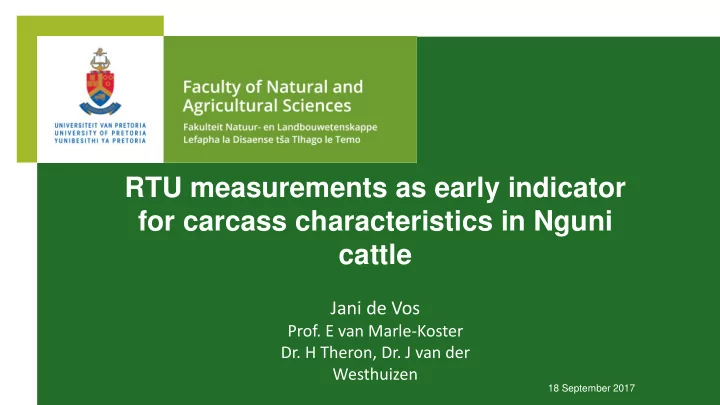

RTU measurements as early indicator for carcass characteristics in Nguni cattle Jani de Vos Prof. E van Marle-Koster Dr. H Theron, Dr. J van der Westhuizen 18 September 2017
Contents: Background Aim Materials & Methods Results Discussion Conclusion & Recommendations Acknowledgements References Yolanda Venter
Background ▪ SA – 13.7 million heads of beef cattle ▪ Per capita consumption 2016/2017 - 20.9kg/year (DAFF 2016) ▪ 75% cattle finished in feedlot (DAFF, 2016) ▪ Majority of cattle marketed through abattoirs come from feedlots Yolanda Venter 3
Cattle breeds finished in feedlots: 5% 5% 16% Bonsmara 3% Hereford 4% Simmentaler Limousin 5% SA Angus Beefmaster 12% Drakensberger 5% Sussex Charolais 4% Holstein Afrikaner 5% 12% Santa Gertrudis Brahman/ Simbra/ Brangus 6% Other/ non-descripts like Nguni 9% 9% Created from: Scholtz & Theunissen, 2010 4
Background • Majority of cattle in feedlots • Bos Taurus and cross breeds • Non-descript cattle dominate the emerging sector with the Nguni and Brahman breeds also playing a significant role (Scholtz & Theunissen, 2008) • Investigate the opportunity for Nguni cattle in feedlots • Due to growing numbers • Limited veld for finishing (Mapiye et al ., 2007; Strydom, 2008) https://www.google.co.za/search?rlz=1C1AVNE_enZA679ZA679 &biw=1366&bih=638&tbm=isch&sa=1&q=large+Nguni+herd+afri ca&oq=large+Nguni+herd+africa&gs_l=psy- ab.3...10182.11627.0.12081.6.6.0.0.0.0.0.0..0.0....0...1.1.64.psy- 5 ab..6.0.0.bH0FUDyh9NE#imgrc=mWTIfTJjV5815M:
Background ▪ Feeding costs – 55-75% of total costs ▪ Growth & efficiency: ADG, Efficiency of use of feed (Muchenje et al ., 2009): RFI, FCR, Kleiber ratio ▪ Carcass quality is main price determinant ▪ Meat quality characteristics: ▪ Fat, juiciness, tenderness & flavour of the meat (Lazzaroni, Gigli & Gabiňa , 2007) ▪ SA consumers prefer a carcass score of A2 (Young animal, lean meat) (Webb, 2015) 6
Background • Evaluation of carcass quality with post mortem slaughter methods are expensive & time consuming • RTU scans: Non-invasive, cost effective, more time efficient Yolanda Venter Use of RTU scans to measure the trait ✓ Eye muscle area ✓ Fat depth ✓ Intramuscular fat (Marbling) (Muchenje et al ., 2008; Lopes et al ., 2016) • Traits have a moderate to high heritability – selection • Limited use of RTU in Nguni cattle 7
Subcutaneous fat Marbling Eye muscle area RTU scan (carcass) 8
Eye muscle area
Background • Breed bulls with these characteristics for improved production 10
Aim The aim was to determine whether RTU measurements can be a sufficient predictor for carcass traits in Nguni cattle raised in feedlots. Yolanda Venter Yolanda Venter 11
Materials & Methods • 60 Nguni bulls finished in a commercial feedlot • Cattle weighed and RTU measurements recorded: Days on test Date Measurements -32 15-Jul Weigh animals: Arrival weight 0 16-Aug Weigh animals: Start weight 9 25-Aug Weigh animals Weigh animals 44 29-Sep RTU measurements: Rump fat, Rib fat Weigh animals 72 27-Oct RTU measurements: EMA, Rump fat, Rib fat 91 15-Nov RTU measurements: EMA, Rump fat, Rib fat 99 23-Nov Weigh animals Slaughtered at A2 carcass grade. 105 29-Nov Slaughter weights 12
Materials & Methods • Real time ultrasound measurements: Marbling (intra muscular fat) Fat depth (inter muscular fat) Eye muscle area (EMA) • Rib fat, eye muscle area (EMA) and rump fat measured using RTU at 72 and 91 days on test respectively. • Animals slaughtered at 105 days at A2 carcass grade. • Statistical analyses were preformed using SAS Enterprise Guide (SAS Institute Inc. 2010). • Phenotypic correlations were estimated between the different traits. 13
Results & Discussion Mean SE Variable Minimum Maximum 225.3 2.9 Start weight (kg) 184 288 378.7 2.5 Slaughter weight (kg) 328.5 444.0 1.6 0.1 ADG (kg/day) 1.2 2.0 14
Results & Discussion Variable Mean Minimum Maximum 6.0 0.1 Rump fat (mm) 3.5 8.8 3.9 0.1 Rib fat (mm) 2.1 6.6 56.0 0.5 EMA (cm 2 ) 44.0 69.0 15
Results & Discussion Current study Comparative Other breeds Nguni studies Slaughter 225.3 220 - 390 413 - 440 weight (kg) ADG (kg/day) 1.6 1.08 – 1.5 1.28 – 1.8 EMA (cm 2 ) 56.0 68.1 – 70.2 75.9 - 84.8 Strydom et al ., 2001; Mapiye et al. , 2007; Strydom, 2008; Scholtz & Theunissen, 2010; Scholtz & Theunissen, 2011; Caetano et al. , 2013; Pereira et al. , 2015; Linde et al. , 2016 16
Results & Discussion: Correlations of traits measured at 72 days on test Slaughter Eye Rump fat Rib fat ADG weight muscle area (EMA) Slaughter 0.35 -0.05 0.06 weight Eye muscle 0.03 0.09 0.1 area (EMA) Rump fat 0.3 Rib fat ADG 17
Results & Discussion: Correlations of traits measured at 91 days on test Slaughter Eye Rump fat Rib fat ADG weight muscle area (EMA) Slaughter 0.49 -0.04 0.1 weight Eye muscle 0.14 0.17 0.17 area (EMA) Rump fat 0.35 Rib fat ADG 18
Conclusion and recommendations: • Average slaughter weight for Nguni tend to be lower compared to composites generally used in feed lots • RTU measurements compared well to previous studies and could be used to predict slaughter weight of Nguni cattle. • The next phase of this study will aim to include RTU in a selection index. 19
Acknowledgments • Nguni breed society for the feedlot trail which took place at Sernick feedlots • BGP which is funded by TIA https://www.google.co.za/search?q=Ann+gadd+art&rlz=1C1AVNE_enZA679ZA679&source=lnms&tbm =isch&sa=X&ved=0ahUKEwjrvfjcl9LUAhVEWxQKHeZJDkUQ_AUICigB&biw=1366&bih=638#tbm= isch&q=Ann+gadd+nguni&imgrc=xyApHbETdSorBM: 20
Thank you 21
Recommend
More recommend